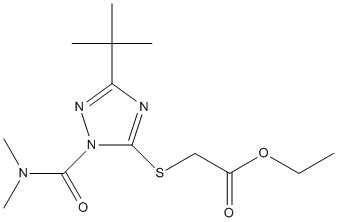Triazamate
General
Type : Carboxamide,Insecticide,Triazol,tert-Butyl,Sulfur Compound
Chemical_Nomenclature : ethyl ((1-((dimethylamino)carbonyl)-3-(1,1-dimethylethyl)-1H-1,2,4-triazol-5-yl)thio)acetate
Canonical SMILES : CCOC(=O)CSC1=NC(=NN1C(=O)N(C)C)C(C)(C)C
InChI : InChI=1S\/C13H22N4O3S\/c1-7-20-9(18)8-21-11-14-10(13(2,3)4)15-17(11)12(19)16(5)6\/h7-8H2,1-6H3
InChIKey : NKNFWVNSBIXGLL-UHFFFAOYSA-N
Other name(s) : Triazuron,1-(N,N-dimethylcarbamoyl)-3-tert-butyl-5-carbethoxymethylthio-1H-1,2,4-triazole,RH-7988
MW : 314.40
Formula : C13H22N4O3S
CAS_number : 110895-43-7 || 112143-82-5
PubChem : 86306
UniChem : NKNFWVNSBIXGLL-UHFFFAOYSA-N
IUPHAR :
Wikipedia :

Target
References (3)
| Title : Field-simulator studies of insecticide resistance to dimethylcarbamates and pyrethroids conferred by metabolic- and target site-based mechanisms in peach-potato aphids, Myzus persicae (Hemiptera: Aphididae) - Foster_2002_Pest.Manag.Sci_58_811 |
| Author(s) : Foster SP , Denholm I , Devonshire AL |
| Ref : Pest Manag Sci , 58 :811 , 2002 |
| Abstract : Foster_2002_Pest.Manag.Sci_58_811 |
| ESTHER : Foster_2002_Pest.Manag.Sci_58_811 |
| PubMedSearch : Foster_2002_Pest.Manag.Sci_58_811 |
| PubMedID: 12192906 |
| Title : Aphicide persistence on spinach and mustard greens - Sweeden_1997_J.Econ.Entomol_90_195 |
| Author(s) : Sweeden MB , McLeod PJ |
| Ref : J Econ Entomol , 90 :195 , 1997 |
| Abstract : Sweeden_1997_J.Econ.Entomol_90_195 |
| ESTHER : Sweeden_1997_J.Econ.Entomol_90_195 |
| PubMedSearch : Sweeden_1997_J.Econ.Entomol_90_195 |
| PubMedID: 9071890 |
| Title : Insecticide-Insensitive Acetylcholinesterase Can Enhance Esterase-Based Resistance in Myzus persicae and Myzus nicotianae - Moores_1994_Pestic.Biochem.Physiol_49_114 |
| Author(s) : Moores GD , Devine GJ , Devonshire AL |
| Ref : Pesticide Biochemistry and Physiology , 49 :114 , 1994 |
| Abstract : Moores_1994_Pestic.Biochem.Physiol_49_114 |
| ESTHER : Moores_1994_Pestic.Biochem.Physiol_49_114 |
| PubMedSearch : Moores_1994_Pestic.Biochem.Physiol_49_114 |
| PubMedID: |